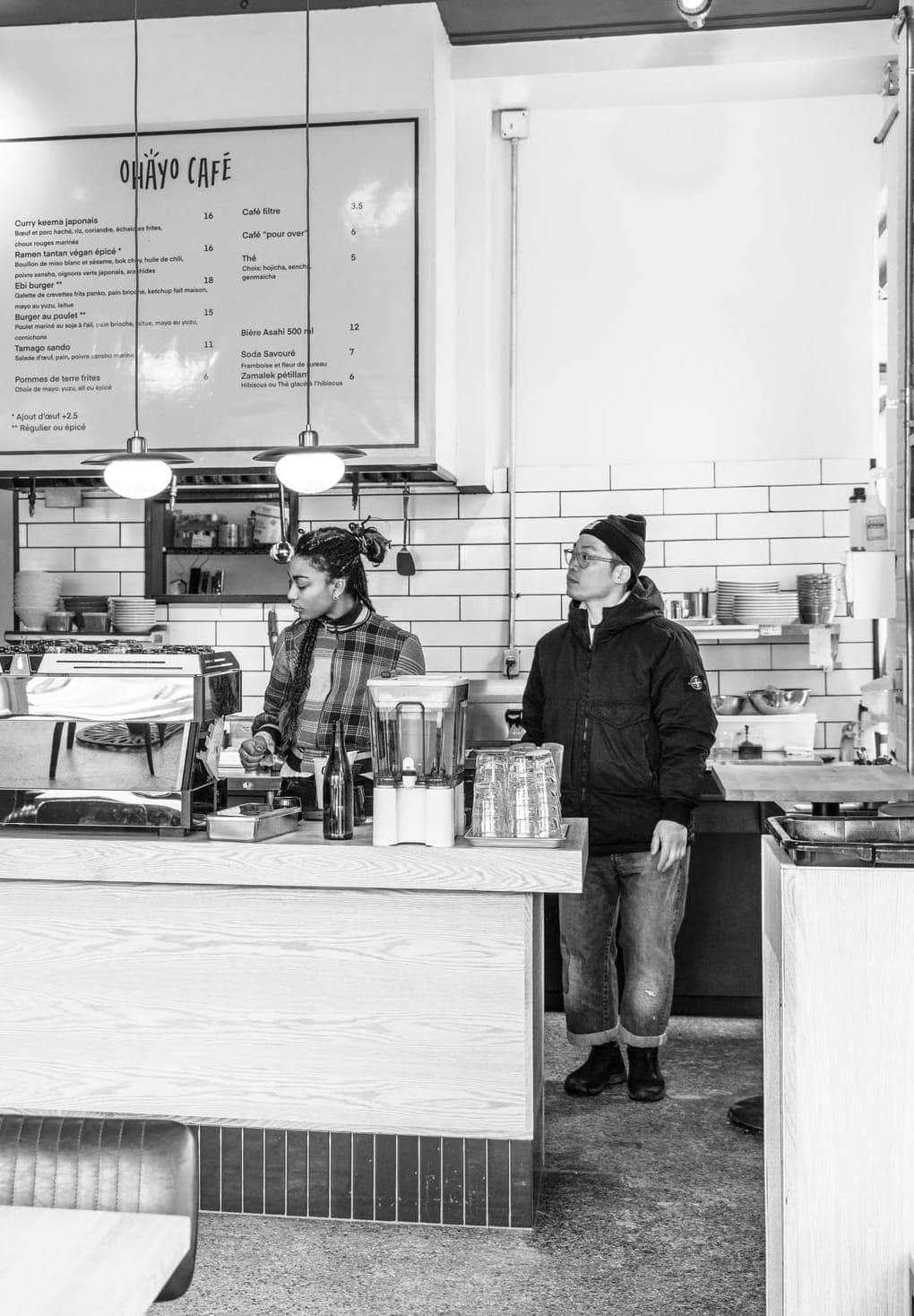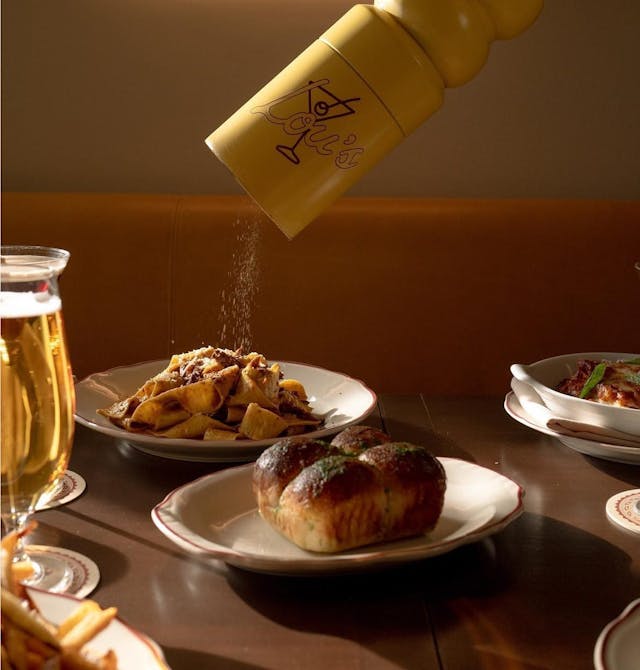Ohayo Café: Saying good morning to Montreal with Japanese yoshoku
Rice, sandos, knives, basketball—this is chef Hiroshi Kitano’s journey from Japan to Montreal, and the restaurants he’s created for the city.
 Ohayo Café is an ode to yoshoku, Japanese dishes based on Western food, which has become a genre emblematic of a certain type of Japanese cuisine. | Photograph: Scott Usheroff / @cravingcurator
Ohayo Café is an ode to yoshoku, Japanese dishes based on Western food, which has become a genre emblematic of a certain type of Japanese cuisine. | Photograph: Scott Usheroff / @cravingcuratorMontrealers know Hiroshi Kitano as the purposeful solo chef in the kitchen at Kitano Shokudo, his soulful Japanese bistro in the heart of the Plateau.
But what they might not know is that twenty years ago, he left his home in Ise City, Mie prefecture on the southern Japanese island of Honshu with a dream to play basketball in America.
Now the co-owner of the light-filled, brand-new Ohayo Café right next door to Kitano Shokudo, Hiroshi’s passage to Montreal—and away from basketball—makes perfect sense.
“We found the best place for me and my family to live,” he says. “We’re super happy here.”

“We found the best place for me and my family to live. We’re super happy here.”
Good Morning, Hiroshi
Hiroshi hasn’t been back to Japan since he left, save for a brief visit years ago, but his devotion to Japanese food and culture is strong.
Ohayo Café, literally meaning “good morning,” is an ode to yoshoku, Japanese dishes based on Western food, which has become a genre emblematic of a certain type of Japanese cuisine.
“It’s very specific to cafés in Japan,” Hiroshi says. “Omu rice, hayashi rice, beef stew: they’re Western, but we’ve been making it for a long time.” Ohayo’s menu also features keema curry with ground beef and pork, an egg sando, and ebi (shrimp) and chicken burgers.
"I want this place to be not only a café, but also providing things that people can buy here for their home."

The chef grew up in an environment where there was a focus on quality food. His grandparents had a large farm, raising Wagyu beef, rice and fruit, and his mom—gifted in the kitchen, as Hiroshi tells it—put all those ingredients together for wonderful home-cooked meals. That same homey feeling is what he aimed to recreate at the 19-seat bistro, which he’s now owned for seven years.
“I never dreamed of being a chef, but I worked in restaurants when I was 16 and 17,” he says. “I was really interested, and I was always hungry—I eat a lot!—so I would often help my mom or cook something for myself.”

Skills Forged in NYC
Hiroshi’s journey from Japan initially took him to San Francisco to learn English, and then on to New York City.
“Many people have a dream to live in New York,” he says. “That didn’t matter to me; people just told me it was nice.”
Rents were high in New York, so Hiroshi began working in kitchens, starting off at Williamsburg’s Bozu izakaya before moving on to Hibino Shokudo in Brooklyn’s Cobble Hill. The owner, Hayashi-san, specialized in shokudo food, which Hiroshi describes as a casual space that serves different dishes as opposed to full, formal meals.

Hayashi-san was “a real chef from Japan,” Hiroshi says. He moved with Hayashi-san to his new restaurant, Hirohisa, in Soho. Hirohisa was a kappo-style restaurant, the first Hiroshi had worked at, and he was keen to learn.
“Kappo is when you sit at the counter, and the chef cooks in front of you with really high quality ingredients,” Hiroshi says. “It can be sushi, but this is traditional Japanese cuisine cooked right in front of you. You feel like you’re in Japan.”
After a few years at Hirohisa, with his American visa expiring, Hiroshi and his wife—by now with two very little ones—didn’t see much of a future staying in New York. The pair started researching possible destinations, with an eye to setting up house in a new country. When they saw Montreal on a few “best places to live” lists, Hiroshi applied to the Canadian government’s Working Holiday program, a few weeks before the deadline—and the cutoff age of 30 years old.

Onward to Montreal
The young chef was ready for a change of lifestyle, but not a change in career.
He started working for the Kinka group at their big izakaya on Sainte-Catherine. After that, along with a partner, he set up Otto Yakitori on St-Mathieu. Later on, they opened Otto Bistro, at the corner of Mont Royal and de Bullion, where Kitano Shokudo and Ohayo Café both now sit.
“I wanted to do something with nicer ingredients, closer to shokudo style. Casual, but high quality food. And no courses, because that takes two to three hours. I like that, but only once in a while.”

Now the sole proprietor of the bistro—Hiroshi separated from the Otto group several years ago to go it alone—he recently renovated, downsizing the space to about a dozen and a half seats. “It’s perfect now,” Hiroshi says.
He’s got a carefully choreographed set of moves in his tiny kitchen, preparing everything from homemade pickles to karaage, ramen, mazemen and artfully arranged bowls of chirashi. It’s only him and Samath Mom, his longstanding employee and close friend, in that space—just the way Hiroshi likes it.

“It’s important for me to focus on what I think and what I believe: How to wash the rice is important to me. Sharpening knives is also cooking. It’s complicated. It’s simple ingredients, but made into a very pure, balanced taste... This is the difference with Japanese cuisine.”
Keeping it Casual
The new project, the 28-seater Ohayo Café, is jointly owned with Samath. “He’d always wanted to have a cafe,” says Hiroshi. The two formed a deep bond when they worked together at Otto Yakitori, and Sam was the first employee at Otto Bistro.

In addition to the yoshoku food—with more menu items appearing daily, like Japanese-style French toast—Ohayo’s coffee program features a range of specialty coffees ground on Mahlkönig and Mythos grinders, with a La Marzocca for espresso-based drinks and classic pour-over gear for filter coffee. Jair Garduño Vazquez, a top-ranked national barista champion based in Montreal, is consulting with the café to ensure a consistent, delicious cup every time.

“Right now the menu is limited, but we want to do more, like selling private importation sake,” Hiroshi says. “Plus Japanese salt, vinegar, soy sauce, mirin... Maybe ceramics. I want this place to be not only a café, but also providing things that people can buy here for their home.”

Is there sufficient demand for this kind of food, served casually? “Montreal is definitely ready for this,” Hiroshi says.
After seven years, Kitano Shokudo has a legion of loyal customers who prefer the calm space, reggae-inflected soundtrack, and Hiroshi’s super-fresh Japanese-sourced fish to more high-end, hyped spots in the city. Ohayo Café is already poised to become another favourite, even after a few short weeks of soft opening.
“It’s important for me to focus on what I think and what I believe: How to wash the rice is important to me. Sharpening knives is also cooking,” Hiroshi says. “It’s complicated. It’s simple ingredients, but made into a very pure, balanced taste.”
“This is the difference with Japanese cuisine.”

Ohayo Café is located at 145 Mont-Royal Avenue East.




![The Best New Restaurants in Montreal [April 2025]](/_next/image?url=https%3A%2F%2Fthemain.ghost.io%2Fcontent%2Fimages%2F2025%2F04%2F021030890026.jpg&w=640&q=75)

